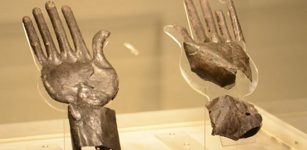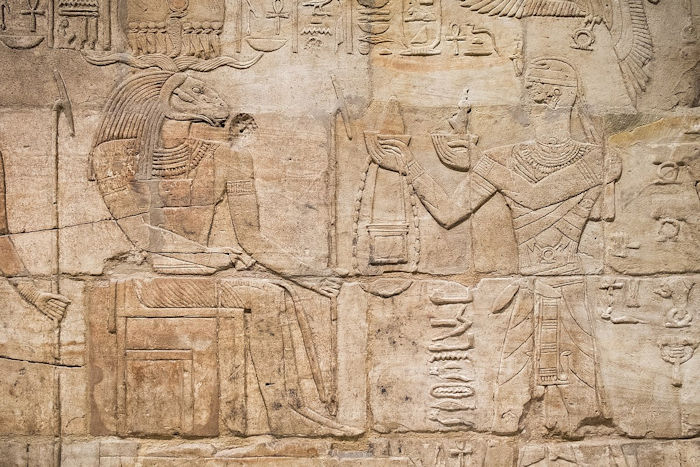Taharqa – The Most Powerful Of The Black Pharaohs
Ellen Lloyd - AncientPages.com - Ancient Egypt is often depicted as an autonomous, stand-alone realm that remained untouched and unaffected by its surrounding African cultures.
There is, however, historical evidence that the balance of power shifted, where the cultures of Egypt and the rest of Africa met and mingled, prompting a revival and reinterpretation of Egyptian customs, gods, and cultural modes of expression.
Taharqa as a sphinx. Credit: Wikipedia/Louvre Museum - CC BY-SA 3.0
For more than 2,000 years, Egypt was the stronger player in the balance of power between itself and its neighboring kingdom to the south, Nubia.
Taharka was the most powerful of the black pharaohs
Taharqa was the son of Piye and the cousin and successor of Shebitku. He was a pharaoh of the Ancient Egyptian 25th dynasty and king of the Kingdom of Kush in Northern Sudan. He reigned between 690 and 664 BC.
Taharqa, "The Black Pharaoh," focuses on a particular chapter in the history of Egypt: from around 750 BCE and in the century that followed, the Nubian rulers upset this balance, seizing the power of Egypt.
Taharqa - life and death of the pharaoh
When Shabaka conquered Lower Egypt and became Nubian king, he was accompanied by his nephew Taharqa, who was about age 20. Later, during Shabaka's reign as pharaoh, Egypt confronted the growing might of Assyria on the battlefield.
During this encounter, Taharqa was at the head of the Egyptian army. However, from a historical point of view, it remains unclear whether the two forces fought. Taharqa's brother Shabataka succeeded Shabaka, making Taharqa his coregent to ensure his succession. About 688 BC, approximately 23 years after the Nubian rule had been imposed over Egypt, Taharqa assumed the throne in his own right.
The next few years were peaceful. Taharqa wanted to control and know about significant events in the neighboring Asian countries. He, therefore, decided to move his capital to Tanis in the Delta.
Granite sphinx of Taharqa, 25th Dynasty, c. 690-664 BC. This statue from Kawa (Temple T) in Sudan shows the Pharaoh's face on a Lion figured sphinx, a form of royal representation borrowed from Middle and New Kingdom art. Credit: Narcissistic Nubian - CC BY-SA 4.0
By 671 BC. Egypt and Assyria again approached a confrontation, so Taharqa prepared to fight for the continued survival of Egypt. But the Assyrian king, Esarhaddon, crossed the Sinai Desert and defeated Taharqa's army on the frontier. In 2 weeks, he was besieging Memphis. The Egyptian military crumbled under the attack of the better-disciplined Assyrian army, armed with iron weapons.
Taharqa fled to Upper Egypt, leaving Esarhaddon to take control of Lower Egypt. Two years later, Taharqa returned with a fresh army and managed to recover possession of the Delta. Still, this success was short-lived, and Esar-haddon's successor, Ashurbanipal, drove Taharqa south again.
It was his final defeat, and he never again tried to campaign in the north. Egypt then entered into a long era of successive foreign rulers.
Taharqa was described by the Ancient Greek historian Strabo as having "Advanced as far as Europe" and (citing Megasthenes) even as far as the Pillars of Hercules in Spain.
Taharqa offers wine jars to Falcon-god Hemen. Image credit: Guillaume Blanchard. Credit: Credit: Wikipedia/Louvre Museum - CC BY-SA 3.0
In biblical depictions, he is the savior of the Hebrew people, as they are being besieged by Sennacherib (Isaiah 37:8-9, & 2 Kings 19:8-9).
Taharqa died in Thebes in 664 BC and was buried at Nuri - North Sudan. His successor was Tantamani, a son of Shabaka.
Evident archaeological traces of the Nubians in ancient Egypt
During his period of Egyptian rule, Taharqa encouraged many architectural projects. The same can be said about his Nubian predecessors. He erected monuments at Karnak, Thebes, and Tanis in Lower Egypt and built several prominent temples in Cush, Egypt's neighbor to the south. Cush played an important role in biblical history.
Pharaoh Taharqa and the gods of Thebes. Standing on the left, he offers "a white loaf" to his father Amun-Re, who is accompanied by Mut, Khonsu, and Montu, Kawa Temple. Credit: Anthony Huan - CC BY-SA 2.0
According to 2 Kings 19:9, "Tirhakah, King of Cush," came to the aid of Hezekiah against Sennacherib, king of Assyria, when his forces laid siege to Jerusalem in 701 BC.
Without such aid, it is hard to imagine that the Kingdom of Judah would have survived.
Taharqa's large temple in Kawa was built on the orders of Taharqa and dedicated to the sun and fertility god Amun-Re. It was intended to give help Taharqa in ruling over his vast kingdom.
It was abandoned in the 3rd century AD and lay buried in sand until excavations in 1930.
Taharqa's shrine is the largest intact Egyptian building in this country.
Archaeologists excavating in Egypt have discovered temples with Nubian inscriptions and highly sophisticated Nubian artifacts inside tombs and palaces. Many archaeological finds were excavated in Meroë and Kawa in present-day Sudan.
Granite statue of Amun in the form of a ram protecting King Taharqa, British Museum. Credit: Rama - CC BY-SA 2.0 fr
Archaeologists and historians have been working hard to preserve the ancient Nubian legacy.
The invading forces from the south appear almost more Egyptian than the Egyptians themselves. Pyramids are built, old traditions and gods are revived, and the new regime appropriates hieroglyphs and Egyptian iconography.
African roots of the Nubians are apparent in connection with their funerary customs and how their culture remained strongly influenced by Egypt even after they retreated to Nubia.
These fascinating findings show that Egyptian and African traits and cultures fuse.
Updated on March 06, 2023
Written by - Ellen Lloyd – AncientPages.com
Copyright © AncientPages.com All rights reserved. This material may not be published, broadcast, rewritten or redistributed in whole or part without the express written permission of AncientPages.com
Expand for referencesMore From Ancient Pages
-
 Valkyries Sigrdriva And Brynhildr: Brave Warriors Who Were Punished By God Odin In Norse And Germanic Mythology
Featured Stories | Apr 4, 2017
Valkyries Sigrdriva And Brynhildr: Brave Warriors Who Were Punished By God Odin In Norse And Germanic Mythology
Featured Stories | Apr 4, 2017 -
 Does Palenque Mask Depict Mayan Ruler Pakal? New Discovery At Palenque
Archaeology | Aug 27, 2018
Does Palenque Mask Depict Mayan Ruler Pakal? New Discovery At Palenque
Archaeology | Aug 27, 2018 -
 Mystery Of Ancient, Overlooked Calico: Early Man Site In The Mojave Desert Of North America
Civilizations | Sep 9, 2021
Mystery Of Ancient, Overlooked Calico: Early Man Site In The Mojave Desert Of North America
Civilizations | Sep 9, 2021 -
 Merovingian Dynasty Of Long Haired Kings
Featured Stories | Jan 18, 2019
Merovingian Dynasty Of Long Haired Kings
Featured Stories | Jan 18, 2019 -
 Ceramics Are Telling The Story Of 14th Century Chinese Trade
News | Jun 28, 2023
Ceramics Are Telling The Story Of 14th Century Chinese Trade
News | Jun 28, 2023 -
 Mystery Of The Silver Hands Discovered In An Etruscan Tomb Full Of Secrets
Artifacts | Jun 12, 2015
Mystery Of The Silver Hands Discovered In An Etruscan Tomb Full Of Secrets
Artifacts | Jun 12, 2015 -
 Kelpie – Supernatural Horse-Liked Creature Lures Humans To Death In Scottish Lore
Featured Stories | Dec 29, 2021
Kelpie – Supernatural Horse-Liked Creature Lures Humans To Death In Scottish Lore
Featured Stories | Dec 29, 2021 -
 Recreation Of Cleopatra’s Ancient Perfume
Archaeology | Aug 26, 2019
Recreation Of Cleopatra’s Ancient Perfume
Archaeology | Aug 26, 2019 -
 Enigmatic Underground Iron Age Monument At Navan Fort And Its Connection To The Ulster Kings Investigated
Archaeology | Aug 24, 2023
Enigmatic Underground Iron Age Monument At Navan Fort And Its Connection To The Ulster Kings Investigated
Archaeology | Aug 24, 2023 -
 Klerksdorp Spheres – Controversial And Out-Of-Place In Time Metallic Spheres From South Africa
Artifacts | Apr 8, 2017
Klerksdorp Spheres – Controversial And Out-Of-Place In Time Metallic Spheres From South Africa
Artifacts | Apr 8, 2017 -
 Biblical City Of Gezer: Important Ancient City Mentioned In The Amarna Letters
Biblical Mysteries | Sep 6, 2018
Biblical City Of Gezer: Important Ancient City Mentioned In The Amarna Letters
Biblical Mysteries | Sep 6, 2018 -
 Abundant Hominin Fossils Dating Back 300,000 Years Excavated In Hualongdong (HLD), East China
Evolution | Aug 7, 2023
Abundant Hominin Fossils Dating Back 300,000 Years Excavated In Hualongdong (HLD), East China
Evolution | Aug 7, 2023 -
 Comet Strike 13,000 Years Ago May Have Changed Human Civilization
Archaeology | Jul 6, 2021
Comet Strike 13,000 Years Ago May Have Changed Human Civilization
Archaeology | Jul 6, 2021 -
 What A Bath, Taken 1,000 Years Ago, Can Tell Us About The Conflicted English Kingdom Of The 11th Century
Featured Stories | Jun 14, 2024
What A Bath, Taken 1,000 Years Ago, Can Tell Us About The Conflicted English Kingdom Of The 11th Century
Featured Stories | Jun 14, 2024 -
 Intact 1,800-Year-Old Roman Sarcophagus With Unexpected Treasures Found In France
Archaeology | Sep 26, 2023
Intact 1,800-Year-Old Roman Sarcophagus With Unexpected Treasures Found In France
Archaeology | Sep 26, 2023 -
 Monumental Grave Of Ancient Greek Poet Aratus Located In Mersin- But It Cannot Be Opened
Archaeology | Jun 4, 2017
Monumental Grave Of Ancient Greek Poet Aratus Located In Mersin- But It Cannot Be Opened
Archaeology | Jun 4, 2017 -
 First Chinese Murals Unearthed In Shimao Ruins Are Over 4,000 Years Old
Archaeology | Aug 22, 2015
First Chinese Murals Unearthed In Shimao Ruins Are Over 4,000 Years Old
Archaeology | Aug 22, 2015 -
 Hagar Qim: “Standing/Worshipping Stones” – Megalithic Complex In Malta Dated To 3600 – 3200 BC
Featured Stories | Feb 19, 2023
Hagar Qim: “Standing/Worshipping Stones” – Megalithic Complex In Malta Dated To 3600 – 3200 BC
Featured Stories | Feb 19, 2023 -
 Strange Ancient Mechanical Flying Animals – Mystery Of The Air Castle – Part 2
Featured Stories | Mar 31, 2020
Strange Ancient Mechanical Flying Animals – Mystery Of The Air Castle – Part 2
Featured Stories | Mar 31, 2020 -
 On This Day In History: Scottish Hero William Wallace Who Met Horrible Death – Is Still Remembered – August 23, 1305
News | Aug 23, 2016
On This Day In History: Scottish Hero William Wallace Who Met Horrible Death – Is Still Remembered – August 23, 1305
News | Aug 23, 2016





